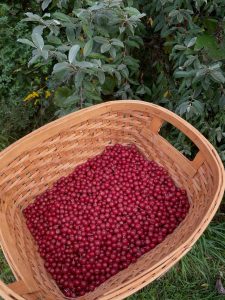
Fall brings an abundance of pored mushrooms, from Boletus to Leccinum to Xerocomellus. Among the edibles are the Suillus species, or slippery jacks. While not all are edible, and not all that are edible are tasty, they often grow in abundance when they pop up, so they’re worth keeping an eye out for.
All slippery jacks have sponge-like pores on the underside of the cap; in most species these will be yellow, though reddish brown is also seen. The top of the cap will usually be some shade of brown, and often appears wet or slimy. Some slippery jacks have spots or texturing on the stipe, and some species have a prominent annulus or ring around the stipe below the cap. Some species will bruise blue when cut or otherwise damaged (wait 15-30 minutes for the color to appear); all are solid inside. These mushrooms are very frequently mycorrhizal with pines of various species, occasionally other conifers depending on species. They’re generally not very large, caps very rarely reaching more than a few inches across, and the stipes tend to be slender. Slippery jacks grow out of soil, not rotting wood, and usually fruit in fall.

Edible Slippery Jacks
Of the edible Suillus species, these are just a few examples:
Short-stemmed slippery jack (Suillus brevipes): Smooth, slimy brown cap with yellow pores, white stipe without spots or texturing, no ring on stipe, does not bruise, spores are brown to greenish-brown. Probably one of the best-tasting of the Suillus species.
Granulated slippery jack (Suillus granulatus): Smooth, slimy brown to reddish-brown cap with yellow pores, white stipe has small brown spots on it, no ring on stipe, does not bruise, spores are brown or greenish-brown. Sometimes considered to be inferior in flavor; may be somewhat more likely to cause gastrointestinal upset even when skinned.
Fat jack (Suillus caerulescens or Suillus ponderosus): Cap orangeish or yellowish and is slimy and smooth or with very slight fibrous texturing, pores are yellow and may bruise brownish, pores sometimes appear to radiate out from the center of the cap, white stipe has no spots but may bruise blue near the base, spores are reddish brown. May have a partial ring on the stipe. Sometimes considered inferior in flavor. This species is mycorrhizal with Douglas fir trees (Pseudotsuga menziesii).
Painted stickycap (Suillus pictus or Suillus spraguei): Cap has reddish brown to pink scales over a yellowish background on top and may have ragged bits of veil hanging from the edges, pores are yellow to yellow-brown and bruise red or brown, stipe is yellowish with a scaly texture and has a network of reddish brown tubes along its length, spores are brown.
Slippery Jill (Suillus salmonicolor): Cap color can vary quite a bit from pinkish brown to olive to cinnamon or clay, pores are yellow to orange to light reddish brown, stipe is white to yellow with dense small brown spots, often has a ring around the stipe, spores light brown. May not be the best of the Suillus for flavor, though others like them properly seasoned.
There are others, though many are considered quite inferior in flavor.

Cooking Slippery Jacks
These mushrooms are not quite as robust as larger Boletus species like Boletus edulis, so their texture and body may soften more in recipes requiring long cooking times. They also don’t always have as strong a flavor as some other mushrooms and may need a little extra seasoning. However, they lend themselves well to sautéing, and they can be breaded and fried as well. Try them in a soup, too! Some people prefer to sautee them to get most of the liquid out until they are chewy or crispy in texture. To preserve excess slippery jacks, slice them up and sautee them and then freeze them.
It is very important that you skin the top layer off of the slippery jacks’ caps, and remove the ring and any other remnants of the veil. While not poisonous, these parts can be difficult to digest and cause gastrointestinal upset. It’s worth the extra effort to avoid several hours of unpleasantness. Removing the pores of older specimens is also recommended to improve texture. Also, a few people may experience dermatological irritation when handling some slippery jacks.

Avoiding Jack’s Toxic Family Members
While there aren’t any Suillus species that are poisonous, there are a few members of the family Boletaceae that are toxic. These include but are not limited to:
Pepper bolete (Chalciporus piperatus): Tannish to rust colored cap with red to reddish brown pores that bruise darker brown; stipe is lighter brown with yellowish filaments and a bright yellow base; spores are brown. Has a very sharp, peppery flavor; when in doubt, you can taste a small piece of a raw specimen in the field to get the flavor and spit it out.
Devil’s bolete (Rubroboletus satanas): A very distinctive mushroom with a white cap and bright red to orange pores and stipe; the stipe is thicker than on Suillus species.
Red-mouthed bolete (Boletus subvelutipes): Cap has various colors including yellow, orange, brown and green; pores are red to orange and often have a yellow ring around the outer edge of the cap; bruises very dark blue to almost black.
Pretty much any bolete with red pores should be avoided, and those that stain blue should be approached cautiously; while some Boletaceae that bruise blue are reportedly edible, members of the genus Boletus that bruise blue are not.
—————
Written by Rebecca Lexa
Rebecca Lexa is a certified Master Naturalist in the Pacific Northwest. She teaches classes on foraging and other natural history topics, both online and off. More about her work can be found at http://www.rebeccalexa.com.
Many of our readers find that subscribing to Eat The Planet is the best way to make sure they don't miss any of our valuable information about wild edibles.
See our privacy policy for more information about ads on this site






